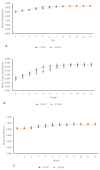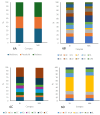Biodiversity assessment and environmental risk analysis of the single line transgenic pod borer resistant cowpea
- PMID: 39434787
- PMCID: PMC11493023
- DOI: 10.7717/peerj.18094
Biodiversity assessment and environmental risk analysis of the single line transgenic pod borer resistant cowpea
Abstract
Background: The discussion surrounding biological diversity has reached a critical point with the introduction of Nigeria's first transgenic food crop, the pod borer-resistant (PBR) cowpea. Questions have been raised about the potential risks of the transgenic Maruca vitrata-resistant cowpea to human health and beneficial insects. Public apprehension, coupled with social activists' calling for the removal of this crop from the nation's food market, persists. However, there is a lack of data to counter the assertion that cultivating PBR cowpea may have adverse effects on biodiversity and the overall ecological system. This research, with its multifaceted objective of examining the environmental safety of PBR cowpea and assessing its impact on biodiversity compared to its non-transgenic counterpart, IT97KN, is of utmost importance in providing the necessary data to address these concerns.
Methods: Seeds for both the transgenic PBR cowpea and its isoline were obtained from the Institute for Agricultural Research (IAR) Zaria before planting at various farm sites (Addae et al., 2020). Throughout the experiment, local cultural practices were strictly followed to cultivate both transgenic and non-transgenic cowpeas. Elaborate taxonomic keys were used to identify arthropods and other non-targeted organisms. Principal component analysis (PCA) was used to evaluate potential modifications in all ecological niches of the crops. The lmer function of the R package lme4 was used to analyze diversity indices, including Shannon, Pielou, and Simpson. The Bray-Curtis index was used to analyzed potential modifications in the dissimilarities of non-targeted organisms' communities.
Results: Examination of ecological species abundance per counting week (CW) revealed no disruption in the biological properties of non-targeted species due to the cultivation of transgenic PBR cowpea. Analysis of species evenness and diversity indices indicated no significant difference between the fields of transgenic PBR cowpea and its isoline. Principal component analysis results demonstrated that planting PBR cowpea did not create an imbalance in the distribution of ecological species. All species and families observed during this study were more abundant in transgenic PBR cowpea fields than in non-transgenic cowpea fields, suggesting that the transformation of cowpea does not negatively impact non-targeted organisms and their communities. Evolution dynamics of the species community between transgenic and non-transgenic cowpea fields showed a similar trend throughout the study period, with no significant divergence induced in the community structure because of PBR cowpea planting. This study concludes that planting transgenic PBR cowpea positively influences biodiversity and the environment.
Keywords: Biodiversity; Diversity indices; Ecology; Ecosystem; Environmental risk analysis; Environmental safety; Evolution dynamics; Non-targeted organisms; PBR cowpea; Transgenic crop.
©2024 Isah et al.
Conflict of interest statement
The authors declare there are no competing interests.
Figures






References
-
- Addae PC, Ishiyaku MF, Tignegre JB, Ba MN, Bationo JB, Atokple IDK, Abudulai M, Dabiré-Binso CL, Traore F, Saba M, Umar ML, Adazebra GA, Onyekachi FN, Nemeth MA, Huesing JE, Beach LR, Higgins TJV, Hellmich RL, Pittendrigh BR. Efficacy of a cry1Ab gene for control of Maruca vitrata (Lepidoptera: Crambidae) in Cowpea (Fabales: Fabaceae) Journal of Economic Entomology. 2020;113(2):974–979. doi: 10.1093/jee/toz367. - DOI - PubMed
-
- Adom D, Umachandran K, Ziarati P, Sawicka B, Appiah SP. The concept of biodiversity and its relevance to mankind: a short review. Journal of Agriculture and Sustainability. 2019;12(2):219–231.
-
- Albajes R, Lumbierres B, Madeira F, Comas C, Ardanuy A. Field trials for assessing risks of GM maize on non-target arthropods in Europe: the Spanish experience. IOBC/WPRS Bulletin. 2013;97:1–8.
MeSH terms
LinkOut - more resources
Full Text Sources

